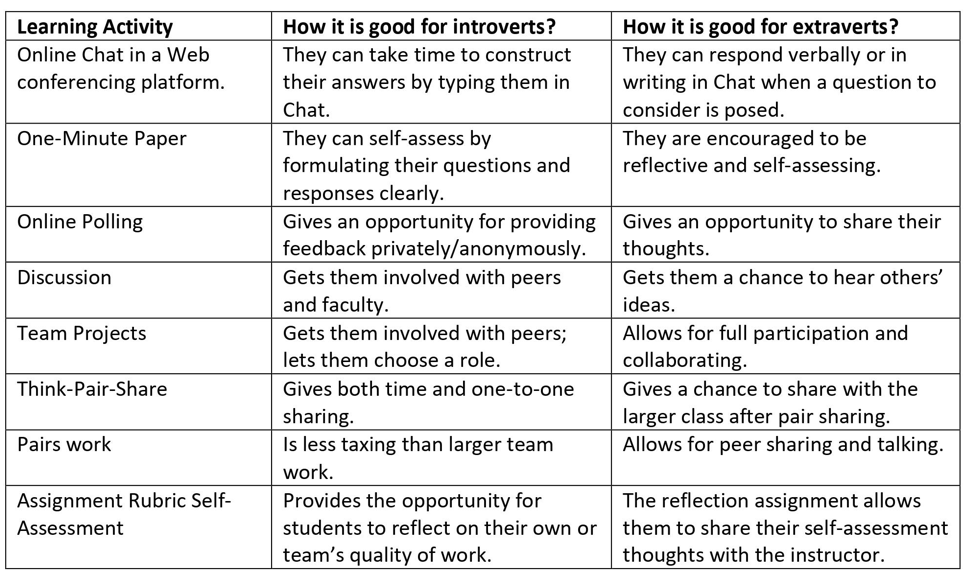You have /5 articles left.
Sign up for a free account or log in.

Microvone/istock/getty images plus
Faculty and instructional designers should consider many factors when designing effective and engaging courses. One they often overlook is a student’s orientation to others and the world around them -- notably, if they are introverted or extroverted.
Carl Jung popularized the theory of psychological types in 1912, and from this, Briggs and Myers developed the well-known Myers-Briggs Personality Type Indicator. In plain language, extraverts (Jung’s spelling) tend to gain energy by interacting with others, while introverts tend to gain energy by reflecting internally. To consider your place on the scale, answer the following: “In general, when attending a large event, do you feel energized and ready for more, or are you tired and drained, even if you had fun?”
Extroverts gain energy from being with others, so courses are often most enjoyable to them when the instructor designs activities that require students to interact within teams, using discussion, games or other active methods. Introverts often prefer to keep more to themselves, so being asked to contribute their ideas on the spot may stress rather than energize them. Extroverts enjoy thinking aloud, sometimes starting with one idea or answer and eventually arriving at a different one, having talked themselves through the whole process. Introverts tend to be quiet, reflecting, thinking, problem solving or writing alone. If a course isn’t designed in a way to provide this type of environment, introverted students may not achieve their learning potential.
The problem: introverted faculty and designers tend to design courses with a more reflective, internalized approach. Extroverted faculty and designers design courses that capitalize on student interaction. They don’t mean to favor one or the other, but they unconsciously gravitate to that type of learning. So unless they have identified ways to include significant learning experiences that champion both introverts and extroverts, the class may appeal to one type more than the other.
To many introverts, it feels that extroverts dominate. “I’m not quiet. I’m cerebral.” This stranger’s spontaneous, transitory analysis made us wonder why being “quiet” or being an introvert in academe seems to be so easily disparaged, discounted and worthy of suspicion in some sectors.
Deidra Faye Jackson has pointed out that academics who demonstrate introverted characteristics are somehow less valued than their extroverted colleagues. Far too often, extroverts look at introverts with a not-yet-ready-for-prime-time bias. Many tend to think being an extrovert should be everyone’s goal. It may be common to have students or faculty think that normal is everyone reaching an extrovert expert level, causing some introverts to suffer from esteem issues and think they are less successful. Yet those students should be properly considered in course design. As many as a third to a half of the population are introverts.
Imagine a world filled with only one type -- we would obviously miss the talents of the other. Where extroverts may rush forward to complete the work by checking the boxes, introverts may examine it in a deeper dig. Developing teams that include both introverts and extroverts working in tandem can create a broader way of thinking critically and innovatively. Course design should value each equally, as we are preparing students to succeed in the workplace, and collaborating effectively with others is a vital skill for success.
Our book, Designing Effective Teaching and Significant Learning, presents a set of situational factors during the planning phase of course design that faculty members should consider. Those situational factors have provided great aha moments for the participants in the Online Course Design Institute (OCDI) where we teach. Participants are asked to examine the characteristics of the learners and the instructor. What faculty and instructional designers often missed is how they have designed their courses in the way they themselves learned.
During the online institute, while analyzing a course’s situational factors, faculty identify their own experiences toward extroversion or introversion. They notice they have tended to shape their course learning activities based on how they have most enjoyed learning. They realize they haven’t considered how to design for the group of students who differ from how they prefer to learn. In their redesigns, participants have intentionally balanced extrovert- and introvert-based learning activities and assessments to broaden the alignment with course outcomes, engaging learning for all.
When to Extrovert and When to Introvert
When designing a course, one should intentionally consider how to guide students to move from extroversion to introversion and vice versa, as both modes of being have benefits. Courses created with attention to both types can help individuals to develop a situational awareness of when to use, and how to shift between introvert or extrovert skills. The goal is teaching students to succeed in both circumstances. In taking on team roles, for example, work can be self-assigned so each student works in their comfort zone to achieve excellence.
In looking at former course class lists, you may notice that extroverts enjoy talking in front of the class or during Zoom-type sessions, contribute more verbally in discussions and work more in groups. Students who are introverts may appear to hold back, not share much verbally at first and silently observe more in teamwork. Instructors are usually able to see more evidence of thinking with extroverted students, as they are more likely to be external about communication.
If the class is working in teams, one person from each team is talking, increasing participation and having more ideas shared. Instructors are able to walk around the classroom, or enter a Zoom room, for example, monitoring progress and providing feedback. But even with several voices speaking, instructors still don’t know if all the others are thinking or sitting passively.
Tanner Higgin suggests rethinking what we expect for participation. Participation is often conflated with thinking out loud, and that’s something at which extroverts excel but with which introverts struggle. Participation can and should mean so much more: asking a thoughtful question, helping others, volunteering, coming to office hours or staying after class, posting in an online forum, doing revisions of work and much more.
Faculty have integrated an increase in active learning and, during the pandemic, have explored greater ways to engage students online. We support these strategies; however, considerations need to be given to what active learning means for both extroverts and introverts. Great course design provides a balance of passive learning, including reading and short lectures; active learning, where students apply and demonstrate concepts; connective learning, where students bridge previous learning to new learning; and reflective learning, in which students analyze the process used and progress made in their learning. Each of these types of learning is effective when balanced in the design and will provide significant learning when combined.
Online Design Strategies
Online learning tends to create more of a balance between extrovert- and introvert-oriented learning. Students learn asynchronously, where they have the time and place to think, act and then analyze how others have responded, encouraging deeper reflection. During synchronous, web-conferencing sessions, you may observe some participants unmuting to share or typing responses in the chat tool. Providing opportunities and time for those who prefer to type responses is a successful strategy for all students. And, as Higgin suggests, asking a good question or posting responses are two excellent ways to participate in a course.
Using the course online discussions tool within the learning management system, students are able to post responses demonstrating content application. With a writing prompt posed, students are given thinking time to communicate a thoughtfully supported response. By requiring students to post before seeing other responses, no one can post the correct answers first and let the others off the hook of doing their own thinking. Students can uncover their own thinking without being influenced by other student posts. Providing rubrics for students to self-assess their posts in depth can also benefit both extroverted and introverted learners.
There is an expectation that everyone will have an opportunity to share and that each response will be valued. As a result, not only can instructors better assess every student’s growth and progress, but learning expands from the sharing of multiple perspectives.
The chart to the right exemplifies how intentionally designed learning activities can benefit introverted and extroverted students. 
Faculty and instructional designers are redesigning courses with improved strategies to meet the needs of all students with the flexibility enough to be dually delivered in both face-to-face and online environments. By analyzing the characteristics of learners and instructors, they can better understand how each course can provide opportunities for introverts and extroverts. Choosing a balance of introverted and extroverted learning activities will meet the goal of full participation and engagement among all students. Faculty members should consider a list of learning activities and assessments that provide students with a choice of how to succeed in their best learning environment to meet the course outcomes.








